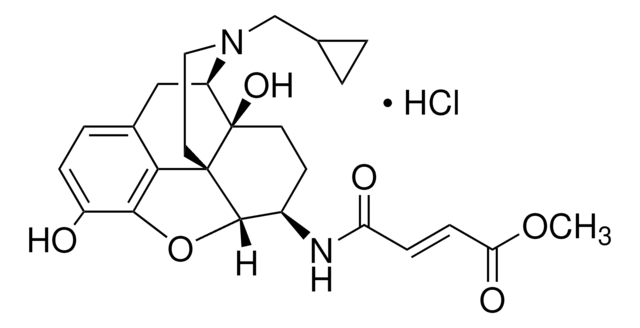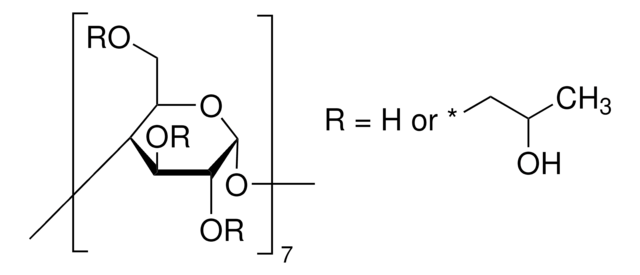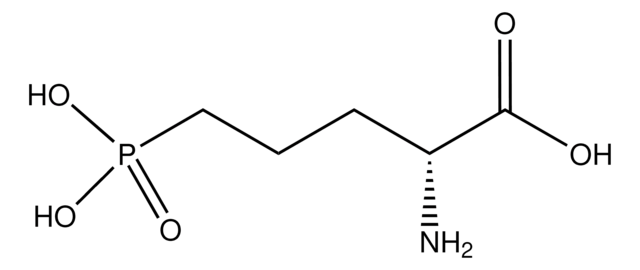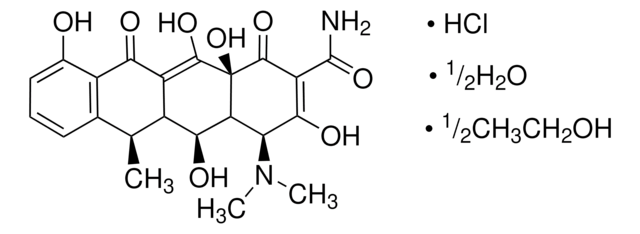SML3265
DAPTA trifluoroacetate
≥95% (HPLC)
同義詞:
Adaptavir trifluoroacetate, D-Ala-Peptide T-NH2 trifluoroacetate, D-Ala-Peptide T-amide trifluoroacetate, Dala1-Peptide T-NH2 trifluoroacetate, Dala1-Peptide T-amide trifluoroacetate, H-D-Ala-STTTNYT-NH2 trifluoroacetate, H-D-Ala-Ser-Thr-Thr-Thr-Asn-Tyr-Thr-NH2 trifluoroacetate, [D-Ala1]-Peptide T-NH2 trifluoroacetate, [D-Ala1]-Peptide T-amide trifluoroacetate
登入查看組織和合約定價
全部照片(1)
About This Item
分類程式碼代碼:
51111800
NACRES:
NA.77
推薦產品
生化/生理作用
DAPTA is a potent CCR5 antagonist, an amidated octapeptide corresponding to an HIV envelope glycoprotein gp120 (gp160)-derived sequence (aa 185-192; the SF-2 isolate) that competes against gp120-CD4 complex for interaction with CCR5 (IC50 = 0.42 nM against gp120CM235 binding to CCR5/CD4 cells, IC50 = 1.5/1.8 nM against gp120BaL/sCD4 or gp120CM235/sCD4 binding to CCR5+/CD4- cells). DAPTA blocks CCR5-dependent HIV host cell entry in cultures and in vivo.
Potent CCR5 antagonist that blocks CCR5-dependent HIV host cell entry in cultures and in vivo.
儲存類別代碼
11 - Combustible Solids
水污染物質分類(WGK)
WGK 3
閃點(°F)
Not applicable
閃點(°C)
Not applicable
Weiwei Yu et al.
Frontiers in pharmacology, 12, 551839-551839 (2021-05-07)
Background: Cigarette smoke exposure (CSE) is a major cause of chronic obstructive pulmonary disease (COPD). The smoke disrupts cell-cell adhesion by inducing epithelial barrier damage to the tight junction (TJ) proteins. Even though the inflammatory mechanism of chemokine (C-C motif)
Valeria Avdoshina et al.
AIDS (London, England), 34(7), 979-988 (2020-02-20)
Postmortem brains of patients diagnosed with HIV-1-associated neurocognitive disorders (HAND) exhibit loss of dendrites. However, the mechanisms by which synapses are damaged are not fully understood. Dendrite length and remodeling occurs via microtubules, the dynamics of which are regulated by
Ze Chen et al.
Cell death & disease, 12(2), 184-184 (2021-02-17)
The pathogenesis of bronchopulmonary dysplasia (BPD), involves inflammatory, mechanisms that are not fully characterized. Here we report that overexpression of C-C chemokine receptor 5 (CCR5) and its ligands is associated with BPD development. Lipopolysaccharide-induced BPD rats have increased CCR5 and
我們的科學家團隊在所有研究領域都有豐富的經驗,包括生命科學、材料科學、化學合成、色譜、分析等.
聯絡技術服務








